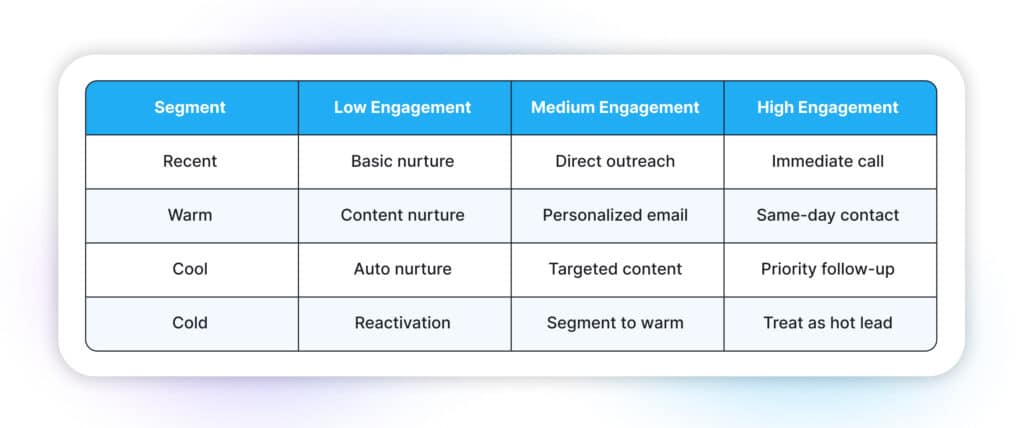If you’re like most high-performance real estate teams, you’re sitting on a goldmine – your database. The average real estate database has a 70% engagement potential, yet most teams achieve less than 30% engagement with their leads. That gap represents thousands—potentially millions—in unrealized commission dollars.
Key Takeaways
- Traditional “hot/warm/cold” lead classification leaves money on the table by ignoring critical behavioral signals
- Behavior matters more than recency when predicting transaction readiness
- Cross-reference time-based segments with behavioral engagement for precise follow-up prioritization
- Start with one high-value segment (100-200 leads) before expanding to more complex approaches
- Strategic segmentation delivers more transactions without additional lead generation costs
Why does this engagement gap happen? It’s simple: managing a growing database while delivering personalized attention to each lead feels impossible. The result is what we’ve all known as the “dead-a-base”—a graveyard of past leads representing massive untapped potential.
But what if there was a better way? What if you could systematically identify which leads deserve immediate attention and which need more nurturing before they’re ready to transact?
That’s where strategic real estate database segmentation comes in. Not the oversimplified “hot/warm/cold” labels you might be using today, but a sophisticated approach that combines time-based and behavioral factors to reveal genuine opportunities hiding in your database.
Why Traditional “Hot/Warm/Cold” Database Segmentation Fails
Let’s start with an uncomfortable truth: If you’re still categorizing leads as simply “hot,” “warm,” or “cold,” you’re leaving money on the table.
This traditional approach to real estate database segmentation suffers from three critical flaws:
1. Oversimplification
Placing diverse leads with unique motivations, timelines, and preferences into three buckets inevitably means treating different leads the same way. The family relocating for a job next month and the couple casually browsing dream homes shouldn’t receive the same follow-up sequence—yet they often do.
2. Time-based limitations
When was the last time you moved a lead from “cold” to “hot” simply because they started searching for properties again after months of inactivity? Traditional segmentation relies too heavily on recency, ignoring that real buying signals can emerge from supposedly “dead” leads.
3. Missed behavioral signals
How a lead interacts with properties—the neighborhoods they focus on, price adjustments in their searches, or viewing patterns—tells you far more about their readiness to transact than how recently they registered on your website.
Consider this real example from one of our client teams: After implementing our real estate database segmentation strategy, they discovered a lead in their database who had been marked “cold” for over a year based on inactivity. However, this lead suddenly began viewing multiple properties in a specific neighborhood within a narrower price range than before. Within three weeks, this “cold” lead closed on a $1.2M property—a transaction that would have been missed entirely under traditional segmentation.
The truth is that behavior matters more than time when predicting transaction readiness.
The Power of Behavioral Segmentation
Behavioral segmentation fundamentally changes how you understand your real estate database. Instead of asking, “When did this lead last engage?” you begin asking, “How is this lead engaging?”
Here are the key behavioral indicators that reveal true intent:
Property View Patterns
The frequency and consistency of property views indicate serious interest. A lead who views 15 properties in a single session is likely just browsing, but someone who returns to view the same three properties multiple times over a week shows genuine consideration.
Search Behavior Evolution
How are search parameters changing over time? A lead who begins with a broad search (3+ bedrooms in the metro area) but gradually narrows criteria (3 bedrooms, 2 baths, within specific school boundaries) is moving closer to a transaction decision.
Geographic Focus Shifts
The concentration of searches in specific neighborhoods after previously broad searches indicates narrowing preferences and increased decision readiness.
Price Range Adjustments
Price adjustments often reflect reality setting in. A lead who starts searching in the $800K-$1M range but gradually shifts to $700K-$850K may have received pre-approval or realized budget limitations—both signs of serious intent.
We’ve seen teams significantly increase their conversion rates simply by reorganizing their follow-up priorities based on these behavioral signals rather than traditional time-based segmentation.
Take the Thompson Team in Austin: After implementing advanced real estate database segmentation, they discovered that leads who viewed the same property three times within a week converted at a much higher rate than those who viewed fifteen different properties once. By prioritizing follow-up for the former group, they closed seven additional transactions in just one quarter—without generating a single new lead.
The Essential 4-Tier Segmentation Framework
While behavioral data should drive your prioritization, time-based segmentation remains a crucial foundational layer in effective real estate database segmentation. We recommend a 4-tier framework that you can then enhance with behavioral overlays:
1. Recent (0-30 days)
These leads are in their initial engagement period. Regardless of their specific behavior patterns, they require prompt, systematic follow-up. The focus here is on establishing a connection and understanding needs.
2. Warm (31-90 days)
At this stage, behavioral signals become increasingly important. Leads showing high engagement should be prioritized over those with minimal activity, even if they entered your database on the same day.
3. Cool (91-180 days)
Most teams make the mistake of reducing contact with these leads. Instead, behavioral segmentation proves most valuable here. Cool leads showing renewed or increased activity should immediately be escalated to high-priority status.
4. Cold (180+ days)
Conventional wisdom says these leads are “dead.” Reality says otherwise. With proper automated nurture and behavioral monitoring, these leads can become some of your most valuable assets—especially since other agents have likely stopped following up entirely.
The power of effective real estate database segmentation comes from cross-referencing time and behavior. Here’s a simplified action matrix:

Implementation Guide – Your First Segment
Ready to move beyond theory? Here’s how to implement your first behavioral segment in your real estate database:
1. Start small
Begin with 100-200 leads. Trying to overhaul your entire database at once can lead to analysis paralysis and trigger spam flags.
2. Choose one high-value behavioral segment
For your first segment, focus on a specific behavior that strongly indicates purchase intent. For example: “Leads who have viewed the same property 3+ times in the last 14 days.”
3. Set up your tech stack
Most CRMs allow for some form of behavioral tracking, though dedicated nurture platforms like RealScout provide more sophisticated tracking capabilities. At a minimum, ensure you can track:
- Property view frequency
- Search pattern changes
- Response to your communications
4. Create your segment
Create a smart list or segment in your CRM that automatically populates based on your chosen criteria. For example, in Follow Up Boss, you might create a Smart List with the criteria: “Viewed Property X 3+ times” AND “Last viewed within 14 days.”
5. Implement a focused follow-up plan
Develop a specific outreach sequence for this segment. Keep it simple at first—perhaps a text message followed by a phone call, then an email with similar properties.
6. Track your results
Monitor key metrics:
- The response rate to your outreach
- Conversion to appointment
- Conversion to transaction
- Time to conversion
One team we worked with created their first real estate database segmentation focusing on leads who had viewed properties in the same neighborhood at least 5 times in 30 days. Within the first month, this single segment—representing just 3% of their database—generated two transactions that otherwise would have been missed.
Beyond the Basics
Once you’ve mastered your first behavioral segment, you can expand to more sophisticated approaches to real estate database segmentation:
Multi-variable segmentation combines multiple behaviors to identify high-probability leads. For example, leads who have viewed 10+ properties AND focused on a specific zip code AND adjusted their price range downward.
Intent-based lead nurture sequences deliver different content based on specific behavioral patterns. For example, a lead focusing on investment properties receives different messaging than someone searching for family homes near good schools.
Automated escalation pathways move leads between segments based on behavioral triggers, ensuring no opportunity falls through the cracks.
These advanced strategies, along with detailed implementation guides, are covered in our comprehensive ebook, “Lead Nurture Mastery: The High-Performance Team’s Guide to FUB + RealScout.” The ebook provides step-by-step instructions for building sophisticated nurture systems that feel personal while running on autopilot.
The Bottom Line: Real Estate Database Segmentation Drives Results
Proper real estate database segmentation isn’t just a nice-to-have—it’s the foundation of effective lead nurture and a critical competitive advantage. Behavioral segmentation puts you leagues ahead in an industry where most agents and teams still use outdated “hot/warm/cold” labels based almost entirely on recency.
The results speak for themselves:
- Substantially higher lead conversion rates
- 70% database engagement (vs. industry average of 30%)
- More transactions without additional lead generation costs
- Better ROI on marketing spend
Most importantly, sophisticated segmentation allows you to work smarter, not harder. Instead of making hundreds of unproductive calls, you focus on leads showing genuine buying or selling signals—delivering better service while closing more deals.






